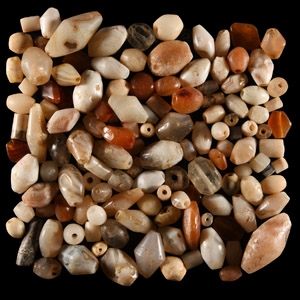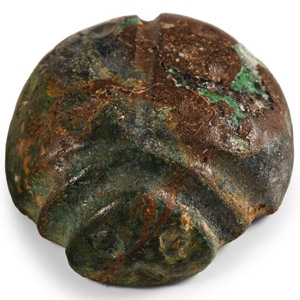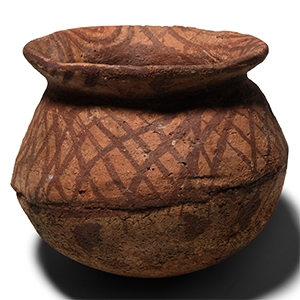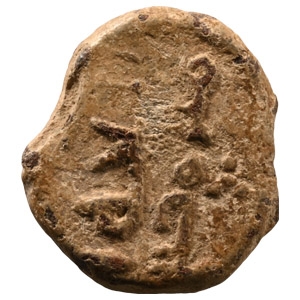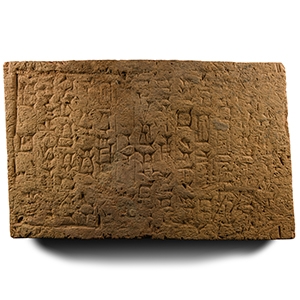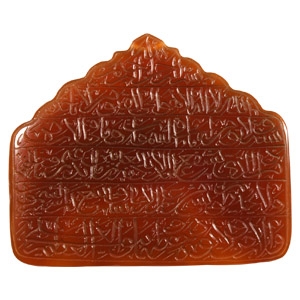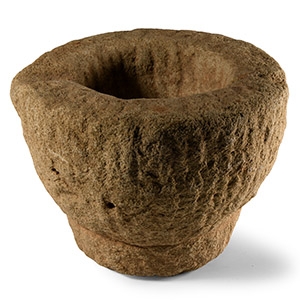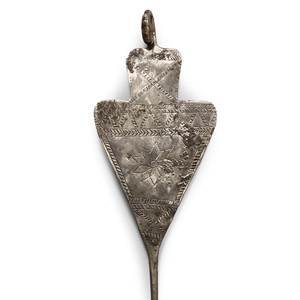Home > Auctions > 4 June - 8 June 2024
Ancient Art, Antiquities, Natural History & Coins
Auction Highlights:
Acquired 1980-2015.
Ex Abelita family collection.
UK private collection before 2000.
On the UK art market.
Property of a London gentleman.
From a collection acquired on the UK art market from various auction houses and collections mostly before 2000.
From an important Cambridgeshire estate; thence by descent.
Cf. similar if more elaborate item in the Metropolitan Museum of Art under accession no.74.51.661.
In the typology of ancient Greek pottery, the kernos (κέρνος or κέρχνος, plural kernoi) was a stone tray to which were attached several small vessels for holding offerings. Its unusual design is described in literary sources, which also list the ritual ingredients it might contain. The kernos was used primarily in the cults of Demeter and Kore, and of Cybele and Attis.
From a collection acquired on the UK art market from various auction houses and collections mostly before 2000.
From an important Cambridgeshire estate; thence by descent.
Cf. Amiran, R., Ancient Pottery of the Holy Land, Jerusalem, 1969, p.46, photo 30, for the type.
The jar belongs to the Early Bronze Period I or II of Canaan, in red decoration with net pattern, and it is unusual having an oval cross-section. Many of these jars were found at Tell el-Far'ah.
From the property of late Mr SM, London, UK, 1969-1999.
Acquired on the London, UK, art market in the 1990s.
Ex London, UK, gallery.
Formerly in a private collection since 1980.
Acquired from the private collection of L.H., Staffordshire, UK.
Previously the property of an East Sussex, UK, gentleman.
From a collection acquired from various auction houses in the UK.
From the estate of Mr R.W., a private Wiltshire, UK, collector; thence by descent.
Accompanied by a copy of a five-page specialist report by James Brenchley.
This lot has been checked against the Interpol Database of stolen works of art and is accompanied by search certificate no.12315 -215546.
Cf. cuneiform text relating to Nebuchadnezzar II and the restorations at Babylon on a terracotta cylinder from Babylon and now in the Metropolitan Museum of Art, New York, under accession no.86.11.282.
The construction of the Hanging Gardens of Babylon and the destruction of Jerusalem's temple are ascribed to Nebuchadnezzar II. He is featured in the biblical Book of Daniel and is mentioned in several other books of the Bible.
UK private collection before 2000.
On the UK art market.
Property of a London gentleman.
with a London, UK gallery 1971-early 2000s.
From the property of late Mr SM, London, UK, 1969-1999.
From a collection acquired on the UK art market from various auction houses and collections mostly before 2000.
From an important Cambridgeshire estate; thence by descent.
Cf. Squitieri. A., Eitam, D. (ed.), Stone tools in the Ancient Near East and Egypt, Ground stone tools, rock-cut installations and stone vessels from Prehistory to Late Antiquity, Oxford, 2019, pp. 237-238, and 275, for examples of similar type.
The later (2nd -3rd century A.D.) Rabbinic tradition emphasised the difference between the permanent mortar (makhtesh kevua) and the movable one (makhtesh metaltelet), with the first being automatically sold with the house, but the second sold only if expressly stated by the vendor. This form of movable mortar was common in the Levant throughout the second half of the 1st millennium B.C.
UK private collection before 2000.
On the UK art market.
Property of a London gentleman.
1021 - 1032 of 2809 LOTS

.jpg)

.jpg)
.jpg)
.jpg)
